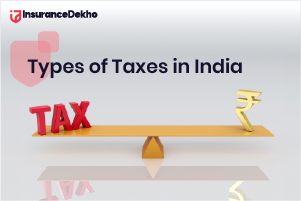Difference Between Pension Plans With and Without Cover
Updated On Jan 23, 2024
As you approach the golden years of your life, retirement planning becomes a cornerstone of financial stability. Choosing the right pension plan is similar to laying a solid foundation for a worry-free and comfortable retirement. Whether you're planning to travel, pursue hobbies, or simply enjoy a peaceful life post-retirement, understanding the nuances of different pension plans is key.
Table of Contents
Let's explore the world of pension plans together and find the one that best fits your retirement dreams.
What are Pension Plans?
Pension plans, also known as retirement plans, are investment plans that help you accumulate a corpus over a period of time to secure your financial future post-retirement. They are designed to provide you with a steady income after you hang up your boots. Let's break down the types of pension plans:
- With Cover Pension Plans: These plans offer the dual benefit of investment and insurance cover. In the event of the policyholder's untimely demise during the policy term, a death benefit is provided to the nominee, ensuring financial security for the family.
- Without Cover Pension Plans: These plans focus solely on building a retirement corpus. They do not include a life cover component, which means no death benefit is paid out. The primary goal is to accumulate savings that can be utilised as a regular income or lump sum after retirement.
Both types of plans have their unique features and benefits, catering to different retirement needs and financial goals. It's about balancing the need for a safety net in the form of life cover with the desire to maximise retirement savings.
Features of With Cover Pension Plans
"With Cover" pension plans are designed to offer not just a retirement corpus but also an insurance cover. Here’s a table summarising their key features:
|
Feature |
Description |
|
Insurance Cover |
Provides life insurance cover, ensuring financial security for the policyholder's family in case of untimely demise. |
|
Death Benefit |
In the event of the policyholder’s death during the policy term, a death benefit is paid to the nominee. |
|
Maturity Benefit |
On surviving the policy term, the policyholder receives the accumulated corpus either as a lump sum or as regular pension payments. |
|
Tax Benefits |
Offers tax benefits under Section 80C on premiums paid and under Section 10(10A) for the pension received, as per prevailing tax laws. |
|
Premium Payment Options |
Flexibility in premium payments – can be single, regular, or limited pay, depending on the policy terms. |
|
Vesting Age |
The age at which the policyholder starts receiving the pension typically ranges from 40 to 70 years. |
|
Policy Term |
Duration of the policy, which can vary, offering flexibility in retirement planning. |
|
Accumulation Phase |
The period during which premiums are paid and the retirement corpus is accumulated. |
These features make "With Cover" pension plans a comprehensive financial tool for retirement planning, offering the dual benefit of creating a retirement corpus and providing a safety net for the policyholder's family. Such plans are suitable for individuals looking for retirement savings along with life cover, ensuring peace of mind for themselves and their loved ones.
Features of Without Cover Insurance Plans
"Without Cover" pension plans focus primarily on building a retirement corpus and do not include life insurance coverage. Here’s a table summarising their key features:
|
Feature |
Description |
|
No Insurance Cover |
These plans do not include life insurance coverage. There is no death benefit payable to the nominee. |
|
Maturity Benefit |
On reaching the maturity of the policy, the policyholder receives the accumulated corpus, either as a lump sum or as regular pension payments. |
|
Tax Benefits |
Tax benefits may be available on the contributions made and on the pension received, subject to prevailing tax laws. |
|
Investment Focus |
The primary goal is to maximise retirement savings, often through investments in various funds or fixed-income securities. |
|
Flexibility in Contributions |
Offers various options for making contributions, including regular, single, or limited pay options, depending on the plan. |
|
Vesting Age |
Specifies the age at which the policyholder starts receiving the pension. This can vary based on the plan’s terms. |
|
Policy Term |
The duration of the policy can vary, offering flexibility in planning for retirement. |
|
Accumulation Phase |
The period during which contributions are made towards building the retirement corpus. |
"Without Cover" pension plans are ideal for individuals who are primarily focused on accumulating a substantial retirement corpus and may already have life insurance coverage elsewhere. These plans offer a straightforward approach to retirement savings, allowing individuals to plan their post-retirement finances without the inclusion of an insurance component.
Differences Between With Cover And Without Cover Insurance Plans
Both "With Cover" and "Without Cover" pension plans offer distinct benefits tailored to different retirement planning needs. Here's a table to illustrate their differences:
|
Plan Type |
With Cover Pension Plans |
Without Cover Pension Plans |
|
Insurance Protection |
Provides life cover, ensuring financial security for the policyholder’s family in case of untimely demise. |
No life insurance cover. Focuses solely on retirement savings. |
|
Death Benefit |
Offers a death benefit to the nominee if the policyholder passes away during the policy term. |
No death benefit. The plan is solely for retirement corpus accumulation. |
|
Maturity Benefit |
Accumulated corpus is paid out at maturity for retirement, either as a lump sum or as a pension. |
The entire corpus accumulated is paid out at maturity for retirement purposes. |
|
Tax Benefits |
Tax benefits on premiums paid and on the pension received, as per prevailing tax laws. |
May offer tax benefits on the contributions and the pension received, subject to prevailing tax laws. |
|
Investment Growth |
Balances between insurance cover and investment growth. Ideal for those seeking security plus savings. |
Primarily focuses on maximising retirement savings through investment. |
|
Flexibility |
Offers various premium payment options and often the choice of fund allocation. |
Often provides more investment options and flexibility in terms of contributions. |
|
Suitability |
Suitable for individuals looking for a combination of insurance protection and retirement savings. |
Ideal for those who already have life insurance coverage and are focusing on building a larger retirement corpus. |
Both "With Cover" and "Without Cover" plans serve distinct purposes. While "With Cover" plans offer the dual benefit of insurance protection along with savings, "Without Cover" plans are more focused on maximising the retirement corpus. Choosing between them depends on individual financial goals, existing insurance coverage, and retirement planning needs.
Conclusion
When planning for retirement, choosing the right pension plan is a critical decision that can shape your financial comfort and security in the later years of life. 'With Cover' and 'Without Cover' pension plans cater to different needs and preferences, offering varied benefits from insurance protection to focused retirement savings. Understanding the basics of these plans is key to making an informed choice that aligns with your long-term financial goals and retirement aspirations.
FAQs on 'With Cover' and 'Without Cover' Pension Plans
Q1: What is a 'With Cover' pension plan?
A1: A 'With Cover' pension plan combines retirement savings with life insurance cover, providing a death benefit to the nominee in case of the policyholder's demise.
Q2: What is a 'Without Cover' pension plan?
A2: A 'Without Cover' pension plan solely focuses on accumulating a retirement corpus and does not include any life insurance cover.
Q3: Who should opt for a 'With Cover' pension plan?
A3: Individuals seeking both retirement savings and life insurance protection should consider 'With Cover' pension plans.
Q4: Are 'Without Cover' pension plans suitable for everyone?
A4: 'Without Cover' pension plans are ideal for those who already have life insurance coverage and are primarily focused on building a retirement corpus.
Q5: Can I switch between 'With Cover' and 'Without Cover' pension plans?
A5: Switching between these plans depends on the policy terms and may not be straightforward. It's essential to understand the policy conditions before making a decision.
Q6: Do 'With Cover' pension plans offer tax benefits?
A6: Yes, 'With Cover' pension plans typically offer tax benefits on premiums paid and on the pension received, as per prevailing tax laws.
Q7: What kind of death benefit is provided in a 'With Cover' pension plan?
A7: In a 'With Cover' pension plan, the nominee receives a death benefit, usually the sum assured or the fund value, in case of the policyholder's untimely demise.
Q8: Are the returns from 'Without Cover' pension plans tax-free?
A8: The tax treatment of returns from 'Without Cover' pension plans depends on the plan structure and prevailing tax laws.
Q9: Is it possible to get regular income from these pension plans after retirement?
A9: Yes, both types of pension plans often provide options to receive the accumulated corpus as a regular pension or annuity post-retirement.
Q10: Can NRIs invest in 'With Cover' and 'Without Cover' pension plans in India?
A10: NRIs can invest in certain pension plans in India, but it's important to check the specific policy terms and understand the tax implications in their country of residence.



























